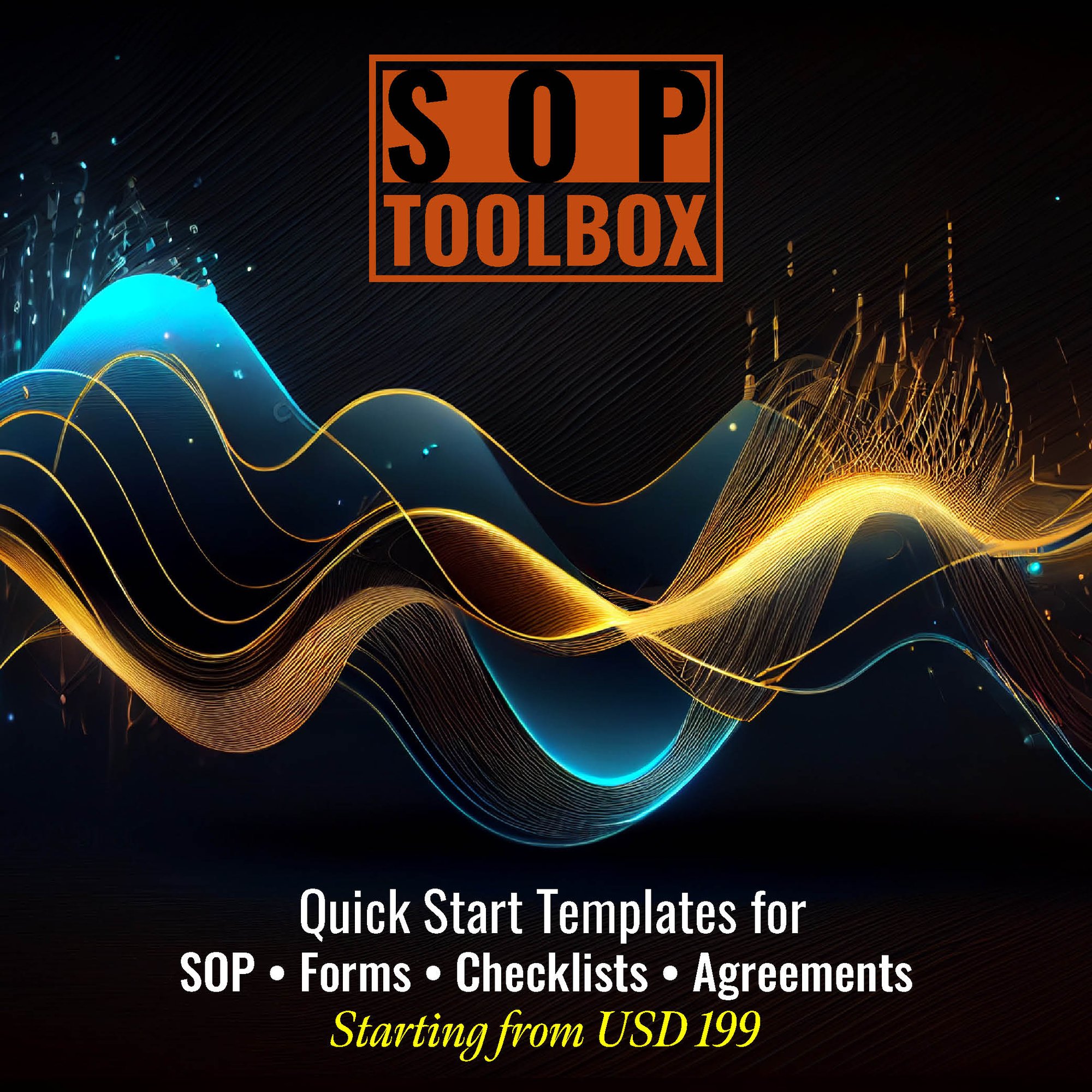An SOP (Standard Operating Procedure) Manual for Oilseed (except Soybean) Farming holds significant value in the agricultural industry, particularly for oilseed crop cultivation. Its importance can be summarized as follows:
-
Operational Consistency: The manual provides a standardized framework for farming operations, ensuring uniformity in planting, cultivation, and harvesting practices. This consistency contributes to the production of high-quality oilseeds.
-
Efficiency: SOPs optimize farming processes, increasing resource utilization efficiency, reducing waste, and ultimately enhancing productivity and profitability.
-
Crop Quality: By following standardized procedures, farmers can maintain and improve the quality of oilseed crops, which is essential for meeting market demands and achieving premium prices.
-
Regulatory Compliance: The manual helps farms adhere to agricultural and environmental regulations, reducing the risk of non-compliance issues, fines, and legal complications.
-
Environmental Responsibility: SOPs can incorporate sustainable farming practices, promoting eco-friendly agriculture and supporting long-term environmental stewardship.
-
Training and Knowledge Transfer: The manual serves as an educational resource for training new farmers and transferring knowledge, ensuring that best practices are passed down through generations.
In summary, an SOP Manual for Oilseed Farming is invaluable for ensuring consistency, efficiency, crop quality, compliance, environmental responsibility, and knowledge transfer in the agricultural sector, contributing to the success and sustainability of oilseed farming operations.
CLICK HERE to download the List of SOPs Document in PDF format. Please share this document with your clients, colleagues and senior officers.
Top 50 SOPs for Standard Operating Procedures (SOPs) for Oilseed (except Soybean) Farming
SOP-807-001: Standard Operating Procedure for Site Selection and Preparation in Oilseed Farming
SOP-807-002: Standard Operating Procedure for Seed Variety Selection in Oilseed Farming
SOP-807-003: Standard Operating Procedure for Seedbed Preparation in Oilseed Farming
SOP-807-004: Standard Operating Procedure for Sowing Seeds in Oilseed Farming
SOP-807-005: Standard Operating Procedure for Irrigation Management in Oilseed Farming
SOP-807-006: Standard Operating Procedure for Fertilizer Application in Oilseed Farming
SOP-807-007: Standard Operating Procedure for Pest and Disease Control in Oilseed Farming
SOP-807-008: Standard Operating Procedure for Weed Management in Oilseed Farming
SOP-807-009: Standard Operating Procedure for Crop Monitoring and Assessment in Oilseed Farming
SOP-807-010: Standard Operating Procedure for Pruning and Thinning in Oilseed Farming
SOP-807-011: Standard Operating Procedure for Harvesting in Oilseed Farming
SOP-807-012: Standard Operating Procedure for Post-Harvest Handling in Oilseed Farming
SOP-807-013: Standard Operating Procedure for Storage Facilities in Oilseed Farming
SOP-807-014: Standard Operating Procedure for Quality Control in Oilseed Farming
SOP-807-015: Standard Operating Procedure for Record-Keeping in Oilseed Farming
SOP-807-016: Standard Operating Procedure for Equipment Maintenance in Oilseed Farming
SOP-807-017: Standard Operating Procedure for Environmental Management in Oilseed Farming
SOP-807-018: Standard Operating Procedure for Crop Rotation in Oilseed Farming
SOP-807-019: Standard Operating Procedure for Irrigation System Maintenance in Oilseed Farming
SOP-807-020: Standard Operating Procedure for Soil Health Management in Oilseed Farming
SOP-807-021: Standard Operating Procedure for Emergency Response in Oilseed Farming
SOP-807-022: Standard Operating Procedure for Integrated Pest Management in Oilseed Farming
SOP-807-023: Standard Operating Procedure for Seed Treatment in Oilseed Farming
SOP-807-024: Standard Operating Procedure for Irrigation Scheduling in Oilseed Farming
SOP-807-025: Standard Operating Procedure for Fertilizer Calibration in Oilseed Farming
SOP-807-026: Standard Operating Procedure for Crop Rotation Planning in Oilseed Farming
SOP-807-027: Standard Operating Procedure for Pollination Management in Oilseed Farming
SOP-807-028: Standard Operating Procedure for Drip Irrigation Setup in Oilseed Farming
SOP-807-029: Standard Operating Procedure for Post-Harvest Loss Prevention in Oilseed Farming
SOP-807-030: Standard Operating Procedure for Grain Cleaning in Oilseed Farming
SOP-807-031: Standard Operating Procedure for Oil Extraction in Oilseed Farming
SOP-807-032: Standard Operating Procedure for Cold Pressing in Oilseed Farming
SOP-807-033: Standard Operating Procedure for Oil Refining in Oilseed Farming
SOP-807-034: Standard Operating Procedure for Packaging in Oilseed Farming
SOP-807-035: Standard Operating Procedure for Transportation in Oilseed Farming
SOP-807-036: Standard Operating Procedure for Market Analysis in Oilseed Farming
SOP-807-037: Standard Operating Procedure for Price Negotiation in Oilseed Farming
SOP-807-038: Standard Operating Procedure for Contract Farming Agreements in Oilseed Farming
SOP-807-039: Standard Operating Procedure for Farm Labor Management in Oilseed Farming
SOP-807-040: Standard Operating Procedure for Health and Safety in Oilseed Farming
SOP-807-042: Standard Operating Procedure for Organic Certification in Oilseed Farming
SOP-807-043: Standard Operating Procedure for Irrigation Water Testing in Oilseed Farming
SOP-807-044: Standard Operating Procedure for Energy Management in Oilseed Farming
SOP-807-045: Standard Operating Procedure for Community Engagement in Oilseed Farming
SOP-807-046: Standard Operating Procedure for Seed Storage in Oilseed Farming
SOP-807-047: Standard Operating Procedure for Traceability in Oilseed Farming
SOP-807-048: Standard Operating Procedure for Risk Assessment in Oilseed Farming
SOP-807-049: Standard Operating Procedure for Biodiversity Conservation in Oilseed Farming
SOP-807-050: Standard Operating Procedure for Organic Waste Management in Oilseed Farming
SOP ToolBox: If you are reading these lines, I am sure you are looking for Standard Operating Procedure guidelines or SOPs itself. In both the cases, searching in internet will not be yielding any great help. Because no company shares their SOP Development Process and certainly don’t share their SOP Documents. The best way to develop an SOP is creating one for yourself. At Fhyzics, we write SOPs day-in and day-out for companies across the globe including some of the Fortune 500 organisations. Our charge ranges from USD 5000 to USD 50000 depending upon the number of processes to be covered. Certainly, this is not affordable to small and mid-size organisations. Hence, we decided to create this SOP ToolBox to disseminate our 8-Step SOP Development Life-Cycle and best practices at an unbelievably low price.
I always say, writing an SOP is somewhere between art and science. So far you may be clueless on where to start and how to progress on an SOP? This will not be the case after you diligently go through this SOP ToolBox. We have summarised all our secrets here to get you started and to deliver a stunning SOP to your management.
-
Canola farming, field, and seed production
-
Flaxseed farming, field, and seed production
-
Mustard seed farming, field and seed production
-
Oilseed farming (except soybean), field and seed production
-
Rapeseed farming, field, and seed production
-
Safflower farming, field, and seed production
-
Sesame farming, field, and seed production
-
Sunflower farming, field, and seed production
Global oilseed production is forecast to grow slightly in 2018/19. Argentina is forecast to rebound from this year's drought, offsetting year-over-year declines in the production of the United States. Rapeseed and sunflower seed are both forecast to continue their growth in production. The palm kernel crop is expected higher in line with palm oil production. Peanut and cottonseed production are expected to decline.
1. Standard Operating Procedures (SOP) Manual for Accounts Department
2. Standard Operating Procedures (SOP) Manual for Finance Department
3. Standard Operating Procedures (SOP) Manual for Customer Service
4. Standard Operating Procedures (SOP) Manual for CRM Department
5. Standard Operating Procedures (SOP) Manual for Credit Department
6. Standard Operating Procedures (SOP) Manual for Treasury Department
7. Standard Operating Procedures (SOP) Manual for Human Resources (HR) Department
8. Standard Operating Procedures (SOP) Manual for Training Department
9. Standard Operating Procedures (SOP) Manual for Learning & Development Department
10. Standard Operating Procedures (SOP) Manual for Administration Department
11. Standard Operating Procedures (SOP) Manual for Front Office
12. Standard Operating Procedures (SOP) Manual for House Keeping
13. Standard Operating Procedures (SOP) Manual for Safety Department
14. Standard Operating Procedures (SOP) Manual for Security Department
15. Standard Operating Procedures (SOP) Manual for Facilities Management Department
16. Standard Operating Procedures (SOP) Manual for Vigilance Department
17. Standard Operating Procedures (SOP) Manual for Legal Department
18. Standard Operating Procedures (SOP) Manual for Information Technology (IT) Department
19. Standard Operating Procedures (SOP) Manual for Sales & Marketing Department
20. Standard Operating Procedures (SOP) Manual for Design & Engineering
21. Standard Operating Procedures (SOP) Manual for Procurement Department
22. Standard Operating Procedures (SOP) Manual for Production
23. Standard Operating Procedures (SOP) Manual for SRM Department
24. Standard Operating Procedures (SOP) Manual for Supply Chain Department
25. Standard Operating Procedures (SOP) Manual for Warehouse
26. Standard Operating Procedures (SOP) Manual for New Product Development Department
27. Standard Operating Procedures (SOP) Manual for Research and Development
28. Standard Operating Procedures (SOP) Manual for Quality Department
29. Standard Operating Procedures (SOP) Manual for Calibration Department
30. Standard Operating Procedures (SOP) Manual for Maintenance Department
Global oilseed consumption is forecast to rise, led by growth in China’s soybean crush. Global soybean demand, measured by total domestic consumption, is expected to grow at a solid rate, slightly lower than production growth. Consumption of other oilseeds is expected up as well, with the exception of cottonseed where global supplies are reduced.
Global oilseed trade is forecast up on higher demand from China. Global ending stocks are projected to fall, as lower carrying stocks coupled with increased consumption will result in lower ending stocks for 2018/19. While the ending stocks of palm kernel and rapeseed are expected to grow, all other oilseed stocks, led by cottonseed and peanuts, are expected to fall.
-
Crosbyton Seed Co
-
Anderson Seed Co Inc
-
Hoffman Inc
-
Young Living Ranch LLC
Constraints in Oilseed Production
- Though these oilseeds are energy-rich crops requiring higher inputs with better management practices, more than 85% of the area under oilseed cultivation falls under rainfed and grown in energy-starved conditions with low inputs and poor management practices due to which the total genetic potential of the crop remains unexploited explaining the sharp fluctuations and giving rise to high risk.
- Due to the higher emphasis on the field grains, the progress has not really been substantial and these crops are generally grown in marginal and submarginal areas where the fertility status of the land is low for the raising of field grains so the farmers use these crops just not to keep the land fallow.
- As these crops are mostly grown under rainfed, farmers have to gamble with the monsoon to get the expected yield. These crops are thus subjected to the vagaries of monsoon and most of the crops suffer due to moisture stress during flowering, peg initiation, and pod filling stages.
- Most of the cultivars and hybrids developed are drought susceptible and the high yielding varieties are also not suitable. They are generally long duration and also do not have a higher level of oil content. There is a scarcity of short, high yielding input responsive biotic and abiotic stress-resistant varieties. As compared to cereals there has been failure of hybridization and seed multiplication programs. Similarly, farmers are not able to get a sufficient amount of these best quality seeds during the sowing period due to a very low seed multiplication ratio.
- Similarly, these crops are generally grown by small and marginal farmers under un-irrigated areas with poor management practices. Similarly, the rate of inputs application is very low and farmers are also not adapted to new technologies and due to fewer land holdings mechanization has also not been so much popular.
- These crops are generally grown as intercrop or in mixture with different crops and those places where these crops are grown as mono-cropping, no crop rotations are practiced resulting in the development of pests and diseases. Similarly, since no legumes are taken in rotation the soil becomes quite drained out of fertility.
- These crops are highly affected by pests and diseases. Pests like aphids, and diseases like powdery mildew, rust causes severe loss in production which can reach as much as 50%. The level of application of plant protection chemicals is also not sufficient.
- There has not been a proper transfer of technology from the lab to the farm. The supply of technology and desired inputs from farm institutions to farmers is very poor.
- Lack of mechanization and sophisticated machinery for sowing and harvesting of the crop as these crops have high scattering properties at the time of maturity. Similarly, due to low efficiency of oil extraction units or expellers, the total amount of oils cannot be extracted.
- Similarly, there is lack of suitable post-harvest technology to prevent post-harvest losses and lack of proper storage, grading, and marketing facilities to avoid deterioration of quality.
Enhancing oilseed production and productivity
- Most of the areas in eastern India after the harvest of paddy are left uncultivated also known as rice-fallow due to the irrigation unavailability. By adopting proper management practices such as raising early duration rice varieties, selection of proper varieties with suitable agronomic practices with integrated pest management these areas can be brought into cultivation of oilseed crops. This practice can offer ample opportunity to promote oilseed cultivation since there is a vast availability of natural resources and fertile land.
- There is a vast scope for extending the crop area under oilseeds through intercropping and sequential cropping as per system suitability with the aim of maximizing profit and enhancing the area of oilseeds.
- Proper extension practices for transfer of technologies from the research lab to farmers field via front line demonstrations, trials, and different pieces of training to convince the farmers as there has been a slow adoption of improved varieties and production technologies and in some cases, this is simply because they are unaware about those technologies.
- One of the major hindrances in the spread of oilseeds is the unavailability of adequate quality seeds. Efforts are needed on the production of hybrid seed and promotion of hybrids having short stature, high oil content properties, and varieties with short durations.
- One of the major constraints is the cultivation of oilseeds under energy deficit conditions under rainfed areas. This can be overcome by promoting several conservation irrigation practices and promoting micro irrigations such as sprinkler and drip irrigation should be promoted.
- There has been the application of primary nutrients i.e. N, P, K to some extent but the secondary and micronutrients such as Zinc, Sulphur, Boron have always been neglected. Several experiments have already shown that the application of such inputs is capable of enhancing the productivity of these oilseed crops. So, different programs like soil health cards, soil fertility maps indicating the nutrients contents and recommendations to be given for raising the production.
- Several research and development programs for the development of modern machinery to improve labor efficiency and productivity is necessary which ensures timeliness of operations and reduces human drudgery.
- Good agronomic practices such as land leveling, seed treatments, good drainage facilities with proper weed, and pest management practices should be chosen and practiced. Since these crops are highly sensitive to waterlogging and crop weed competition( CPCWC 20-30 DAS) care must be given.
- These crops have high capsule scattering properties and oil reduction if harvesting not done at the proper maturity stages. So harvesting has to be done at the right stage.
- Strengthen the post-harvest storage and processing facilities such as crushing, solvent extraction, oil refining, and hydrogenation.
- Favorable government policies such as imposing heavy import duty for raw materials and vegetable oils and increasing consumer awareness for the benefits of indigenously produced vegetable oils to discourage importer nexus and promote the indigenous oilseed sector.
- Government schemes such as crop insurance with reasonable minimum support prices with an added bonus to attract the new growers or avoiding the shifting of farmers towards other crops or professions.
- National Mission on Oilseeds and Oil Palm (NMOOP)
https://nmoop.gov.in/ - Canadian Oilseed Processors Association (COPA)
https://copacanada.com/ - National Oilseed Processors Association
https://www.nopa.org/
This SOP manual briefly describes the services, challenges, major companies and solutions for improvement in this industry. Global oilseed production is forecast to grow 5 percent in 2020/21, primarily on a rebound in soybean output in the United States and South America. Global oilseed production is projected to reach a record of 605.9 million tons on record plantings. Soybean production is forecast to rise 26.6 million tons to a record 362.8 million tons, less than 3 million tons above the previous record set in 2018/19. Rapeseed, peanut, sunflower seed, and palm kernel production are also forecast to increase with both sunflower seed and palm kernel reaching records. Copra and cottonseed production are forecast to fall in 2020/21.
Research By : Mohammed Ijas
Keywords: sop, manual, policy, sop meaning, sop full form, standard operating procedure, full sop, user manual, sop is, user guide, instruction manual, owners manual, sample sop, operators manual, sop example,standard operating procedure examples, abbreviation sop, standard operating procedure sample, milk sop, sop document, sop process,m manual, operating procedures, operating process, sop meaning in hindi, standard procedure, sop standard operating procedure, sop top, sop writing, standard operating procedures manual, sop meaning in english, sample sop for mba, standard operating procedures examples in office, product manual, sample sop for ms, maintenance manual, sop security, sop in research, sop in business, whats sop, standard of operation, sop set, sop procedure, sop marketing,sop training, sop hotel, sop, sop meaning business, sop form, sba sop,sop software, help manual, sop it, army sop, company sop, sop sap, o m manual, standard operating procedure examples for small business, shop manual, sop manual, sop meaning in business, purpose of standard operating procedures, sop full meaning, standard operating procedure meaning, sop military, sop standard, sop meaning medical, hr sop, sop production, purpose of sop, sop management, warehouse sop, sales sop, sop pharma, sop manufacturing, sop creation, sop laboratory, ms sop, sop full form in hindi, sop front office, sop customer service, sop online, gmp sop, sop purchasing, sop pharmacy, sop safety, sop for project management,sample sop for australian student visa, sop meaning in tamil, sop system, best sop, sop up, sop in english, sop for mechanical engineering, sop for university,sop in malay, sop lab, sop for business analytics, sop model, sop in pharmacy, developing sops, standard operating procedure examples manufacturing, sop full form in retail,sop full form in medical, sop engineering, sop application, writing standard operating procedures, procurement sop, sop maintenance,standard operating procedure nhs, sop clinical trial, sop operations,sop in construction, operating procedures manual, standard operating procedure ppt, standard procedure meaning, sop ppt, a sop, sop document meaning, sop def, sop full form in safety, sop quality control, sop for college, sop quality, sop service, types of sop, sop for engineering management, sop document sample, benefit of sop, preparing sop, standard operating procedure in hindi, sop for visa, sop compliance, sop protocol, sop aviation, sop meaning in chat, standard operating process, sop meaning military, sop for business management, standard operating procedure software, sop list, sop medical, sop logistics, sop project, sop for it department, sop call center, standard work procedures, sba sop 50 10, sop meaning in logistics, standard operating procedure laboratory, test sop, sop sample for ms, drafting sop, sops meaning in tamil, sops meaning in telugu, sop automotive, standard operating system, sop cafe, sop slideshare, sop ap, sop bank, sop in retail, creating standard operating procedures, sop admin, document control sop, pharmaceutical sop,sop in pharmaceutical industry, statement of purpose harvard, sop examples for ms, quality assurance sop, sop in clinical research, nursing sop, sop for transportation, sop policies, sops are specific to a process, sop in hindi, standard operating procedure for warehouse picking, master sop, list of sop for pharma, pharmaceutical sop examples, types of standard operating procedures, retail sop, sample sop for ms in mechanical engineering, standard operating protocol,sop supply chain, system operating procedure, sop rules, example of sop in research, sop in food industry, sop for international business management, sop for hospitality management, sop for hr department, army sop example, sop standard operating, office sop, hr standard operating procedures, preventive maintenance sop, sop for purchase department, human resources sop, fire department sops, information technology sop, operating procedure example, administration sop,sop for retail store, indian sop, construction management sop, sop hotel front office, example sop document, standard and procedures,working sop, sop for maintenance department, sop hrd department,sop full form in hotel industry, sop full, sop for human resource management, laboratory sop examples, standard operating procedure for quality control, sop for ms in mechanical engineering, sop meaning army, security standard operating procedures, sop machine, sample sop for internship, sop for hotel management, sample sop for masters, qa sop, developing standard operating procedures, standard operating procedure document, product recall sop, marketing statement of purpose, it standard operating procedures, equipment sop, sop purpose example, sop shipping, sop for sales and marketing,converting pos to sop, workshop sop, standard operating procedure manufacturing, digital marketing standard operating procedures, following standard operating procedures, sop ki full form, sop for nursing procedures, an sop, purchase sop for manufacturing company, sop a, statement of purpose for mba marketing, full meaning of sop, sop for research internship, research sop sample,vendor qualification sop, sop purchasing and receiving, sop meaning in visa, sop for admission, standard operating procedure medical office, sop in industry, sop sales marketing, navy sop, project management standard operating procedures, sop it support, standard operating manual, security operating procedures, statement of purpose for international business, procurement standard operating procedures, communication sop, sop full form in pharma, minimum sop, sop health and safety, product sop, sop for marketing department, sop in medical terms, sales standard operating procedure, sop purchase order, department sop, customer service standard operating procedures, clinical sop, marketing standard operating procedure, sop standard operating procedure example, construction standard operating procedures, standard of operations procedures manual sample, sop for facility management, sop full form in education, standard operating procedure in food industry, visa sop,sop for business administration, company sop meaning, sop work, sop operating procedure, sop for summer internship in engineering sample, general administration sop, sop for administrative duties.






.jpg?width=645&height=337&name=Standard%20Operating%20Procedure%20-%20SOP%20ToolBox%20(1).jpg)











